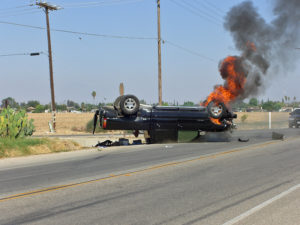
What Caused Elvis’s Death? What Part Did Minor Traumatic Brain Injury Play?
My family and I visited Memphis this summer. Since this year is the 40th anniversary of Elvis’s death, we made it a priority to tour Graceland. It was a first for all of us, and we had a great time. While touring Elvis’s private residence, I started wondering about the actual facts and circumstances of his death. So I googled it. What I found was very interesting and it caused me to ask the question: What really caused Elvis’s death? Over the past 40 years, there has been a lot of speculation about what led to Elvis’s death. Was it a simple heart attack? A drug overdose? It’s no secret that Elvis indulged in drug use, especially during the later years of his life. It’s also no secret that he had serious health problems for the last 10 years of his life. He suffered from hypertension, Cushing’s disease and high cholesterol, among other things. He was hospitalized and treated on multiple occasions for a variety of health issues. His history of health problems and drug use have made the conclusions of a drug overdose or a heart attack seemingly obvious for decades. But was there something the doctors were missing? Is there another piece to this puzzle? At least one doctor, Dr. Forest Tennant, who has extensively researched Elvis’s death and traumatic brain injuries (TBIs), thinks so. (insert link to article) As I learned while reading this article, standing in Elvis’s famed Jungle Room, Dr. Tennant concludes that head trauma suffered by Elvis was downplayed and could have been the root cause of his death. There are at least 4 documented instances of Elvis suffering head trauma as an adult. While some of those instances may seem minor, it’s important to note that even minor brain damage from head traumas can lead to significant consequences. In 1956, Elvis was knocked in the head during a fight at a gas station. Also in 1956, Elvis was struck in the head by a man at a hotel bar. In 1958, he was repeatedly knocked down throughout some rough roller skating “war games”; these were so rough that Elvis provided each player with an oxycodone/aspirin pill. The last, and most severe, head trauma occurred in 1967 when Elvis fell and hit his head hard on a porcelain bathtub and was knocked unconscious. After these incidents, as we now know is common with even mild traumatic brain injuries, Elvis’s behavior changed. He became erratic and irrational. He would refuse to bathe, take unknown pills, and complain of headaches, insomnia and pain all over. Elvis’s decline in health and increase in drug abuse may be attributed in large part to having suffered a TBI. Similarly, some of the health issues Elvis suffered, including infections and pain, may have stemmed from Autoimmune Inflammatory Disease that developed or was accelerated as a result of his head traumas. Autoimmune Inflammatory Disease occurs when brain tissue is leaked into the general blood circulation. This tissue is toxic to the rest of the body and when leaked, the antibodies start attacking normal tissue throughout the body. This can cause pain all over the body, including the spine, joints and muscles. It’s possible Elvis was using drugs to self-medicate and manage this pain. If Elvis or his family had known he was suffering from an autoimmune disease, brought on by traumatic brain injuries, is it possible he could have received treatment rather than relying on drugs to self-medicate? Could he have been saved? While we can’t change history, we can learn from the past and work to prevent others from suffering the same fate in the future by knowing the facts about TBI. TBIs can cause paranoia, reclusive behavior, poor hygiene, hostility and drug use. An Autoimmune Inflammatory Disease can cause headaches as well as pain throughout the body, and many patients are misdiagnosed with fibromyalgia. If you or a loved one has suffered head trauma, whether from a car crash or motorcycle wreck, or from a fall, be aware of the symptoms of traumatic brain injury and make sure to receive a full and complete workup and diagnosis.





